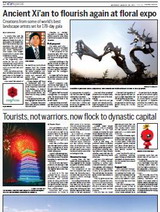
|
Tourists, not warriors, now flock to dynastic capital
|
||
|---|---|---|
|
By Zhang Zhao ( China Daily )
|
||
|
Updated: 2011-03-28
|
||
|
|
||
|
The northwestern city of Xi'an will showcase its historical glory as well as its modern charm to the world when it hosts this year's International Horticultural Exposition from April 28 to October 22. More than a million years ago Xi'an was home to Lantian Man, a subspecies of Homo erectus older than the better-known Peking Man. Around 7,000 years ago Banpo village in the east of today's Xi'an became one of the earliest examples of a matriarchal clan community. The city of Xi'an was founded about 3,100 years ago. It was the capital city of 13 dynasties that together lasted more than 1,100 years. As early as in the Han Dynasty (206 BC- 220 AD), the city was the political, economic and cultural center of China, and the hub for international trade. It was the world's earliest metropolis with a population of more than 1 million people. Historians say Xi'an's importance to China is what Rome is to Europe. The city enjoys fame equal to Athens, Rome and Cairo as one of the world's ancient capital cities. As a cradle of Chinese culture, Xi'an and its neighboring areas have a vast number of archeological sites and relics. There are 669 key cultural heritage sites, 138 of which are on the State protection list. There are also nearly 9,000 ancient tombs and nearly 6,000 other archeological sites. Historical heritage Among them, the best-known are the Terracotta Warriors, regarded by the Chinese as equal to the Seven Wonders of the Ancient World. The mausoleum of the first Qin emperor near Xi'an where the Terracotta Warriors stand was one of the first UNESCO World Heritage Sites in China. The smiling terracotta statues wore leather armor when they were put into the mausoleum, but after thousands of years, their clothing and their wooden weapons have broken down in the soil, explained archaeologists. Armless, naked statues found in 1990 in Yangling mausoleum of the Han Dynasty are among the most recent discoveries near Xi'an. Archaeologists compare them to the famous armless statue of the Venus de Milo. Xi'an is now using its profound history to develop tourism. A number of cultural heritage parks have opened in recent years, including Daming Palace and Tang Dynasty Paradise. Many sites near the city are also becoming tourist attractions. Last year, Xi'an welcomed almost 53 million tourists, including 52 million from China and more than 1 million from overseas. With revenue of 40.5 billion yuan ($6.17 billion) in 2010, up 36.4 percent over the previous year, the tourism sector is now a key industry in the city. The city government has moved to improve the infrastructure and environment for tourists while leading efforts to enhance services and develop new tourism products. The city has 335 travel agencies and more than 100 star-rated hotels with more than 20,000 rooms. There are two national 5A scenic spots and 11 4A scenic spots in the city. A number of theaters, nightclubs and other entertainment facilities have also been built in recent years. Artists have composed operas, musicals and dance shows based on local history and culture that were warmly received by tourists. Local handicrafts such as silk, porcelains, painting, paper cutting and wheat straw patchwork are favorite souvenirs for tourists from around the world. Regional hub With improved transportation infrastructure, Xi'an is a regional hub today. Railroads and highways starting from the city link east, central and western China. The city also has more than 12,000 taxis. The Xi'an Xianyang International Airport is one of the nation's most important airports, served by more than 150 air routes operated by 20 companies. More than 400 planes take off and land in Xi'an every day. It will also become the first city in Northwest China with a subway system when its first line begins operation in late September. A second line is scheduled to be completed in 2013. The city is also one of the nation's regional centers of industry, innovation and finance. It is a major center of defense-related, aerospace and information technology as well as higher education. It ranks third nationally in the number of college students after Beijing and Shanghai. (China Daily 03/28/2011 page12) |





